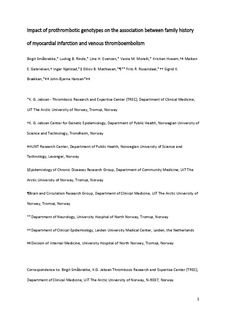| dc.contributor.author | Småbrekke, Birgit | |
| dc.contributor.author | Balteskard Rinde, Ludvig | |
| dc.contributor.author | Evensen, Line Holtet | |
| dc.contributor.author | Morelli, Vania Maris | |
| dc.contributor.author | Hveem, Kristian | |
| dc.contributor.author | Gabrielsen, Maiken Elvestad | |
| dc.contributor.author | Njølstad, Inger | |
| dc.contributor.author | Mathiesen, Ellisiv B. | |
| dc.contributor.author | Rosendaal, Frits Richard | |
| dc.contributor.author | Brækkan, Sigrid Kufaas | |
| dc.contributor.author | Hansen, John-Bjarne | |
| dc.date.accessioned | 2020-01-21T11:56:44Z | |
| dc.date.available | 2020-01-21T11:56:44Z | |
| dc.date.created | 2019-05-28T10:31:26Z | |
| dc.date.issued | 2019 | |
| dc.identifier.citation | Journal of Thrombosis and Haemostasis. 2019, 1-9. | nb_NO |
| dc.identifier.issn | 1538-7933 | |
| dc.identifier.uri | http://hdl.handle.net/11250/2637217 | |
| dc.description.abstract | Background
Family history of myocardial infarction (FHMI) is known to increase the risk of venous thromboembolism (VTE).
Objectives
To investigate the effect of prothrombotic genotypes on the association between FHMI and VTE in a case‐cohort recruited from a general population.
Methods
Cases with a first VTE (n = 1493) and a subcohort (n = 13 072) were sampled from the Tromsø study (1994‐2012) and the Nord‐Trøndelag health (HUNT) study (1995‐2008). The DNA samples were genotyped for rs8176719 (ABO), rs6025 (F5), rs1799963 (F2), rs2066865 (FGG), and rs2036914 (F11). Participants with missing information on risk alleles (n = 175), FHMI (n = 2769), and BMI (n = 52) were excluded. Cox regression models were used to estimate hazard ratios (HRs) with 95% confidence intervals (CI) for VTE. To explore the role of prothrombotic genotypes for the association between FHMI and VTE, we (a) included the genotypes in the multivariable‐adjusted models and (b) assessed the joint effects between FHMI and genotypes on VTE risk.
Results
The FHMI was associated with a 1.3‐fold increased risk of VTE (HR 1.32, 95% CI 1.16‐1.50) and 1.5‐fold increased risk of unprovoked VTE (HR 1.47, 95% CI 1.22‐1.78). The risk of VTE by FHMI did not alter after adjustment for the five genotypes. The combination of FHMI and the different prothrombotic genotypes did not result in an excess VTE risk (i.e. no biological interaction).
Conclusions
Our findings suggest that the risk of VTE by FHMI is not explained by rs8176719 (ABO), rs6025 (F5), rs1799963 (F2), rs2066865 (FGG), and rs2036914 (F11). The combination of FHMI with prothrombotic genotypes had an additive effect on VTE risk. | nb_NO |
| dc.language.iso | eng | nb_NO |
| dc.publisher | Wiley | nb_NO |
| dc.title | Impact of prothrombotic genotypes on the association between family history of myocardial infarction and venous thromboembolism | nb_NO |
| dc.type | Journal article | nb_NO |
| dc.type | Peer reviewed | nb_NO |
| dc.description.version | acceptedVersion | nb_NO |
| dc.source.pagenumber | 1-9 | nb_NO |
| dc.source.journal | Journal of Thrombosis and Haemostasis | nb_NO |
| dc.identifier.doi | 10.1111/jth.14493 | |
| dc.identifier.cristin | 1700766 | |
| dc.relation.project | Stiftelsen Kristian Gerhard Jebsen: SKGJ-MED-015 | nb_NO |
| dc.relation.project | Norges forskningsråd: 248817 | nb_NO |
| dc.description.localcode | Locked until 24.5.2020 due to copyright restrictions. This is the peer reviewed version of an article, which has been published in final form at [https://doi.org/10.1111/jth.14493]. This article may be used for non-commercial purposes in accordance with Wiley Terms and Conditions for Self-Archiving. | nb_NO |
| cristin.unitcode | 194,65,20,0 | |
| cristin.unitcode | 194,65,20,15 | |
| cristin.unitname | Institutt for samfunnsmedisin og sykepleie | |
| cristin.unitname | Helseundersøkelsen i Nord-Trøndelag | |
| cristin.ispublished | true | |
| cristin.qualitycode | 1 | |
